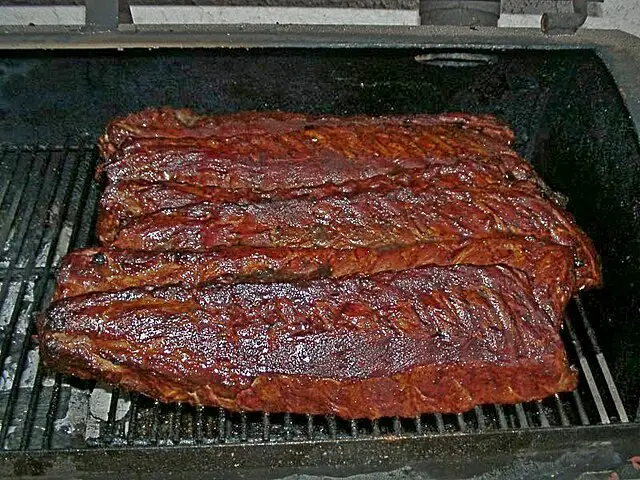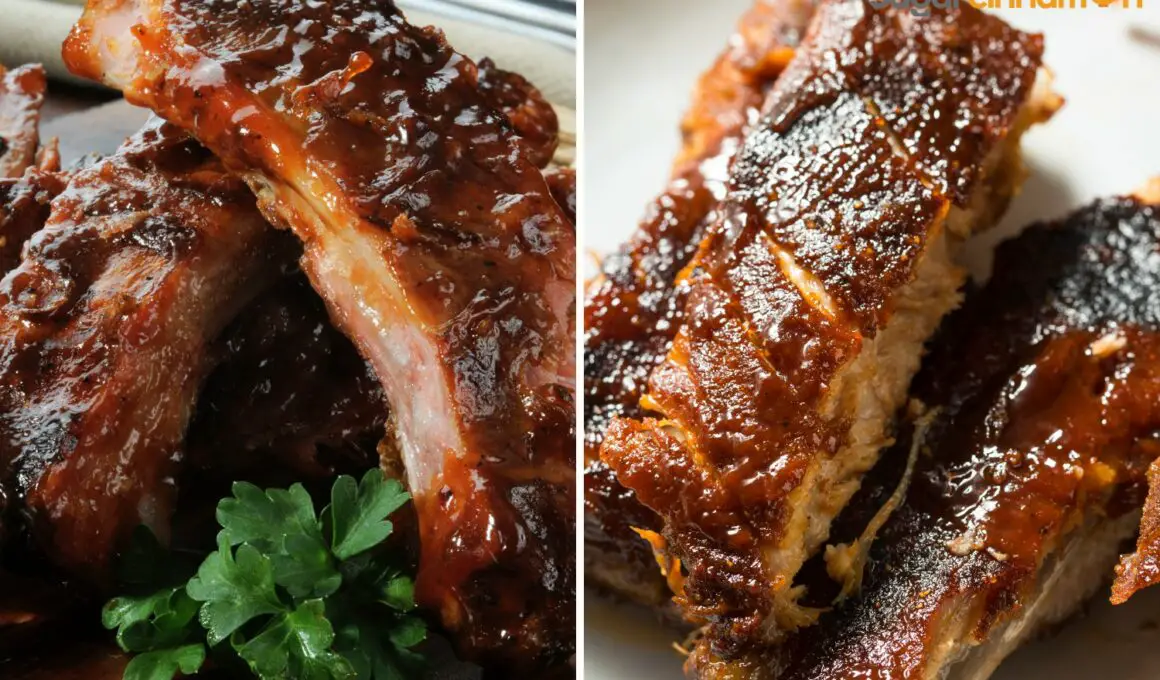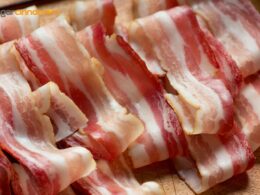Table of Contents Show
Summer is an exciting time of the year, mostly due to the anticipation to fire up the grill and explore different cuts of meat. Oftentimes, the cut you grill will be based on the meat you are craving and when it comes to ribs, you want to choose a cut that yields a high amount of fat marbling as this gives them lots of flavor. Pork ribs are always a treat whether you cook them outdoors or indoors.
St Louis Ribs have always been used interchangeably with Baby Back, but are they the same? To ensure you have a good taste in meat, you must look for ribs that have good fat marbling. The two most commonly sold types are Baby Back and St Lgouis ribs but understanding these two ribs cuts is important for the perfect BBQ.
The difference between baby back ribs and St Loius ribs is mainly in shape. St Louis ribs are flatter and straighter while baby back ribs are shorter and curved too. Both rib cuts offer flavorful and mouthwatering meat St Louse ribs are easier to brown since they are flatter, and they cook more evenly due to the higher amount of fat marbling.
You have to be selective when picking a rib cut for grilling and this is because the ribs must have good fat marbling but not too much fat. So, how do you pick the best cut of rib? Are St Louis ribs better than baby back? What is the difference between St Louis ribs and Baby Back Ribs? Learn about these two common rib cuts before your next backyard BBQ.

What Are Baby Back Ribs?
Baby Back Ribs as the name implies as smaller than the other rib cuts which is how they got their name. This rib cut comes from the part of the ribs that are connected to the backbone and it lies beneath the loin muscle where the spine and ribs meet. Baby back ribs are sometimes called pork loin ribs, loin ribs, or back ribs.
The best way to cook baby ribs will be through indirect cooking and this is because the curve bones will make it challenging to cook evenly with direct heat.
Baby back ribs are not called baby because they come from small pig-like many people think, they are baby-sized in comparison, they are around 6 inches on the longest end and taper down to around 3 inches on the shorter end.
What Are St Louis Ribs?

St Loius Ribs are the most common type of pork ribs and they are easy to cook. St Louis ribs are also known as Louis-style spare ribs and they are the meatier ribs that come from the belly of the hog after the belly has been removed. This cut has more fat than other rib cuts which is what enhances its flavor, it is also flatter which makes it very easy to brown.
St Louis is simply from the belly side of the pig hence these ribs have many connective tissues and tough cartilage attached to them which is often removed by cutting down the surrounding tissues.
They are sort of the flat rib type and need to be marinated for several hours in a dry rub or sauce mixture. Rather than slow cook it, barbecues start by cooking on the grill or covering it with a dry rub before smoking as well.
These ribs have a lot of fat marbling on them which is what makes them very flavorful but not a healthy option. There are however lots of bones as well and it’s the perfect rib cut for making BBQ that will cater to a large group.
Baby Back vs St Louis Ribs: What’s The Difference?
When comparing both baby back and St Louis ribs, you should know that both deliver delicious flavor. The obvious difference between baby back and St Louis is the shape and the fat content. Louis-style spare ribs are from the belly section and they are larger and longer than the baby back ribs Also, St Louis ribs take well to bring cooked on extremely low and slow heat.
The baby back ribs are quite meaty too which is why they are easier to marinate in any sauce, St Louis ribs, on the other hand, require you to be very selective, and if you are looking to eat healthier and stick to a diet, the baby back ribs are a much-preferred option.
Not only does St Louis have a higher amount of fat, but it does also have lots of bones as well which makes them very flavorful when cooked properly. St Louis spare ribs are lots cheaper than baby back ribs.
Their preparation method tends to differ as well due to the high-fat content in St Louis ribs which is exactly what gives the meat its distinct pork flavor and it doesn’t need to be seasoned as much as you would with baby back ribs.
How to Prepare Baby Back Ribs
Baby back loin ribs are slightly curved from the top of the rib cage below the loin muscle but with the right tip, you can cook these rib cuts to be tender and flavorful. Whether you are having a family backyard BBQ dinner, a Labor Day cookout, or celebrating the end of summer with some nice smoked ribs, here are important tips that can help.
1. Remove The Membrane
First, you want to remove the membrane by laying your baby-back ribs on a flat surface. Then slide a knife between the meat and the thin where the slippery membrane sits, This part is too rough to consume so slowly pull it away from the meat and if you can’t pull it off at once, break it into sections.
2. Apply The Perfect Seasoning Blend
To season your baby back ribs, apply a small amount of vegetable oil to the ribs then follow with a generous amount of dry rub, you can use a classic BBQ marinade that is made with garlic, paprika, or chili powder. A light coat of mustard can also help tenderizer while infusing it with flavor.
3. Marinate Overnight (Optional)
You can choose to marinade your baby back ribs overnight in the fridge if you have enough time but if you don’t have the time, let the ribs soak in the marinade for at least 1 hour at room temperature. Marinating for longer periods lets the flavor penetrate through the meat fully.
4. Smoke to The Perfect Temperature
We highly recommend that you perfect the smoking temperature as this can determine how your baby back ribs or any cuts of meat will turn out. The low and slow cooking method is perfect as your meat gets to absorb the woody flavor, but the smoking wood should be used in moderation so it does not overpower your pork ribs.
Set your smoker to 225 degrees Fahrenheit and allow your smoke ribs to cook for 3 hours or until it reaches the desired temperature. Note that baby back ribs will take roughly 4 hours and they should be wrapped after 2 hours to maintain their beautiful color and tenderize it.
How to Prepare St Louis Ribs
How to prepare St Louis ribs is a lot similar to that of baby back ribs but it’s a bit difficult to get to due to all of its cartilage. The process of smoking St Louis ribs is not that difficult as you can purchase one where the cartilage has been trimmed off, but this is expensive and it is not that difficult to trim them off.
1. Remove The Membrane And Cartilage
Plop your Louis-styled ribs on your cutting board and using a sharp knife, do you notice that flap of meat that looks out of place? Slice it off close to the bones to remove it, ensure you cut across the joint, and remove any excess tips and cartilage. Then slide a knife between the meat and the slippery membrane, lift this, and pull it away from the meat.
2. Season
You can go ahead and season with your secret favorite rub and if you don’t have any, you can prep the pork meat with vegetable oil, so the rub adheres to it. For some classic BBQ rub, you can use include paprika and chili powder or you go with a mix of cayenne pepper and garlic powder, or try dry mustard coriander and brown sugar (make sure you break all the chunks of the brown sugar).
3. Marinate Overnight (Optional)
Marinating the meat overnight depends on the time you have. To maximize the flavor, marinate your Louis ribs in the fridge overnight but if you are short on time, then marinate it for at least 1 hour at room temperature before cooking.
4. Grill
Grilling is perfect for traditional St Loius-styled ribs, simply preheat your grill to 350 degrees Fahrenheit and place the charcoal on the right or left side of the grill. Next lay the racks in the center of the grill and allow it to cook for a half hour.
Remove the ribs from the grill and add the glaze or simply slather with apple cider vinegar, then wrap them with aluminum foil, this would prevent stalling then return to the grill to cook for 30 minutes.
After the ribs are properly cooked or using a thermometer probe, cook till it reaches an internal temperature of 200 degrees Fahrenheit. Remove from the grill and let it rest for one hour before slicing.
Can You Substitute One Rib For The Other?
Baby back ribs and Louis-styled ribs differ when it comes to flavor, shape, fat content, and the amount of meat they have to offer.
Although they differ in style, with proper preparation, these two ribs offer tender juicy meats. So, yes, you can substitute one rib for the other and still get the desired result. But since baby back rib is smaller, you will need 1 1/2 of the amount as St Louis ribs.
St Loius style ribs are larger than baby back ribs which means they also take longer to cook, Baby back ribs require 1 1/2 hours to 2 hours to cook at 300 degrees Fahrenheit. While St Louis ribs will take between 2 1/2 to 3 hours hence when substituting, approximate properly.
Final Thoughts
The contest between St Louis and baby back ribs can be settled with meat versus fat. The baby back rib is the meaty one which makes it easier to marinate in a sauce while the St Louis rib requires you to be selective with it as it’s also meatier but filled with fat too.
Both ribs are sweet and flavorful, how they turn out depends on the cooking method. But keep in mind that St Louis has more succulent and fattier characteristics, the fat from it is bursting with flavor. However, if you are trying to stick to a diet and watch your weight then the baby back ribs are a better option.













